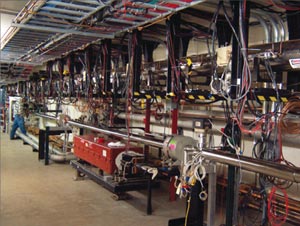After 10 years of preparation, a team at Fermilab has achieved electron cooling at high energy. On 9 July, on the first attempt, the Electron Cooling Group observed the interaction between an 8 GeV antiproton beam and an electron beam travelling at the same speed. Although commissioning will take another couple of months, accelerator experts have already begun to use the electron-cooling system to reduce the size of antiproton beams prior to their injection into the Tevatron proton-antiproton collider. Ultimately, they hope that electron cooling will increase the collider’s luminosity by 50-100%.

Electron cooling, first proposed by Gersh Budker in 1966, is a proven method at low energies, but Fermilab, funded by the Office of Science of the US Department of Energy, is the first laboratory to extend the method to relativistic beam energies. The higher-energy system has been developed at Fermilab under the leadership of Sergei Nagaitsev, who joined the laboratory in 1995. Installation of the system in the Recycler storage ring, which stores and cools antiprotons, began in August 2004.
Constructed in the late 1990s, the Recycler is 3.3 km in circumference and uses permanent magnets to store antiprotons at 8 GeV. The new electron-cooling system mainly reduces the longitudinal emittance of the beam by “mixing” the antiprotons with a continuous 4.3 MeV beam of electrons, which are provided by a Pelletron accelerator adjacent to the ring. The electron beam, with a current of up to 0.5 A and power of up to 2 MW, travels for approximately 20 m along the same path as the antiprotons, and is then sent back to the Pelletron for recirculation. The electrons interact with the antiprotons, cooling the beam and reducing the spread in longitudinal momentum: antiprotons travelling too fast are slowed down as they bump into electrons, and slow antiprotons are sped up as they are hit by faster electrons.
A stochastic-cooling system, based on the principle invented by Simon van der Meer at CERN in 1972, already reduces the transverse emittance of the Recycler’s antiproton beam. With the start-up of the electron-cooling system, it is the first time that two beam-cooling systems have been used concurrently, according to Nagaitsev, and that electron cooling has been used to improve beams for a collider.








